The south bank of Florence is an irresistible jumble of opulent palaces, hip boutiques, and restaurants. From the bustling Santo Spirito to the authentic San Frediano, Oltrarno (literally ‘beyond the river Arno’) will have you escaping the tourist throng to eat, drink, shop, and bask in the cradle of the Italian Renaissance like a local.
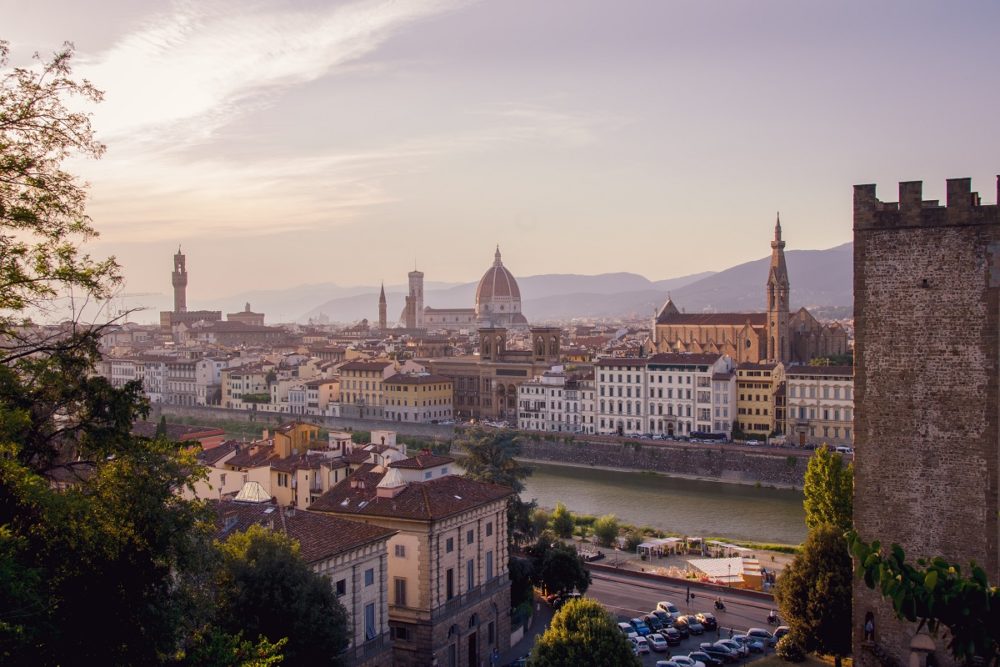
Cityscape of Florence viewed from Oltrarno (photo: Jeff Ackley for Unsplash)
Florence unfurls her secrets once you leave behind the Duomo crowds and cross the Ponte Vecchio to explore Oltrarno – literally ‘the other side of the Arno’: the rîve gauche of the Tuscan capital. From grandiose Medici dwellings to rambling gardens, old-world elegance looms large here, and there’s enough of it to remind any traveller that there’s so much more to Firenze than Michelangelo’s David and Botticelli’s The Birth of Venus.
These days, Oltrarno attracts an undeniably cool crowd of staunch locals and savvy expats. It’s packed with hidden haunts, whether in the courtyard of old palazzos, on hotel rooftops boasting panoramic views, or down a beguiling back street. It’s also the place to find some of the tastiest, cheapest, and most authentic meals the city has to offer… And yes, we’re counting gelato as a meal! Revel in the small neighborhood charms of San Spirito and San Frediano, climb to the highest sightseeing spot in Florence, or simply loll in a deckchair along the river bank, taking life at as gentle a pace as the Arno itself. Oltrarno has all the elements to help you express that indefinable fiorentinità (Florentinity, or the art of being Florentine).
Things to do
When exploring Oltrarno, expend your energy on the vast palaces and gardens, then seek a reward in the form of a Spritz with a view. Palazzo Pitti is an essential stop for any first time visitor. The largest private residence in Florence, this fortress-like complex was founded by ambitious Florentine banker and rival to the Medici family, Luca Pitti, who unfortunately died bankrupt before its completion, at which point the Medicis snapped up the palace for themselves. The community of Oltrarno originated here, with noble families settling in the shadow of the imposing palace.
Palazzo Pitti now holds no fewer than four museums, making it home to one of the city’s most extensive art collections (and in Florence, that’s saying something!). If you don’t have time to linger over all the treasures within, opt for the Galleria Palatina (worth it for Napoleon’s bathroom, some luminous Titians, masterpieces by Caravaggio and Rubens, and above all, the cheeky, double-sided nude of Cosimo I’s dwarf), marveling at every square centimeter of frescoed, gilded ceiling along the way. Attention, art buffs: the gallery also possesses nine works by Raphael, more than any other museum in the world.
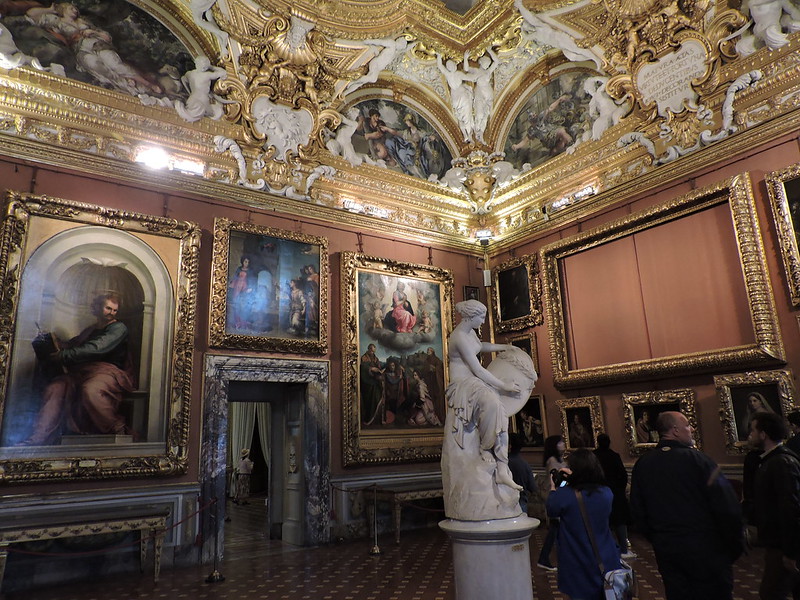
Galleria Palatina, Palazzo Pitti (photo: Dimitris Kamaras via Flickr)
Pitti Palace is flanked by the Boboli Gardens that sprawl over 45,000 square meters (11 acres), more an open-air museum than a simple expanse of green. Stay hydrated and wear comfortable shoes to explore the Medici’s lush playground, an impeccable Italian-style garden to rival the French pomp of Versailles. Start with the Fountain of Bacchus, where we once again encounter Cosimo’s dwarf, this time as a sculpture, in a compromising position. For a splendid panorama, head up the tree-lined hills to the quaint, teal-colored rococo Kaffeehaus building. And if there’s a appointment not to miss in Florence, it’s 3.30pm sharp in front of the Grotta di Buontalenti; this magnificent manmade cave with its intricate stone carvings is only open to the public for five minutes each day.
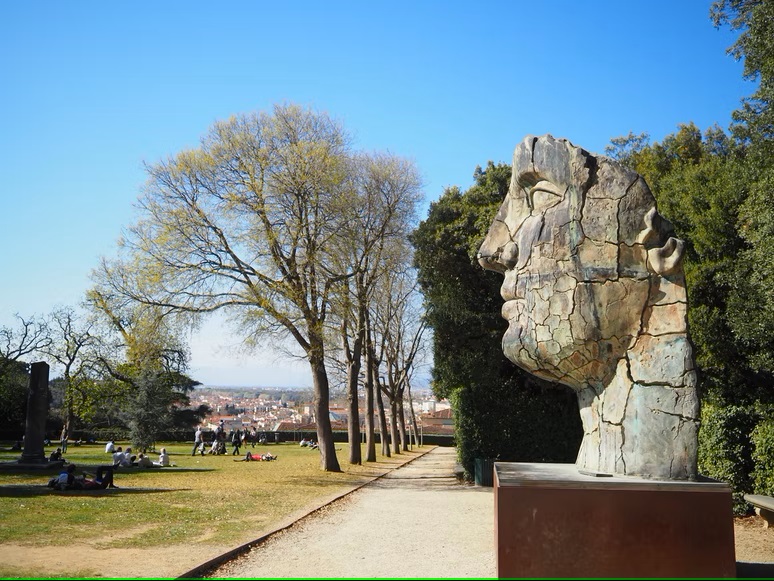
Tindaro Screpolato bronze statue by sculptor Igor Mitoraj at the Boboli Garden (photo: Trev Morris via Flickr)
If you’re not already worn out, you may wish to tackle the highest point in the city for some unbeatable views. Trek up the steep hill of the idyllic rose garden, Il Giardino delle Rose, pausing to admire the goldfish ponds, before arriving at the Piazzale Michelangelo to take in its stunning vistas over the Arno, and the Cattedrale di Santa Maria del Fiore with its iconic Brunelleschi cupola proud on the skyline.
Between Boboli and the Piazzale Michelangelo lies a more intimate patch of greenery, the Giardino Bardini. Bordered by the medieval walls of the city, this four-hectare (ten-acre) renaissance garden in the hills of Oltrarno offers enchanting views of Florence, and in the spring attracts plant-loving visitors longing to stand under its cascades of bright, delicate wisteria blooms. Continue along the winding path to the Villa Bardini to visit its (almost never crowded) museum, displaying the collection of 19th-century art connoisseur and antiquarian Stefano Bardini.
Around these three green havens, the surrounding neighborhoods of Oltrarno are teeming with intrigue. Start with the locals’ favorite haunt: the Piazza Santo Spirito, a stone’s throw from Palazzo Pitti. Presiding over the light-filled square and its daily street market (which becomes an antique market on the second Sunday of every month) is the unassuming exterior of the 15th-century Basilica di Santa Maria del Santo Spirito. Don’t be fooled by its sober facade and simple rounded gable, this 15th-century church is another perfectly proportioned marvel designed by Filippo Brunelleschi. A teenage Michelangelo sought refuge here in 1492 after the death of his patron; he was even permitted to study the anatomy of corpses from the convent’s hospital. In return for the basilica’s generosity, the great artist sculpted a nude wooden Christ at the cross for the basilica, where it can still be admired from all angles today.
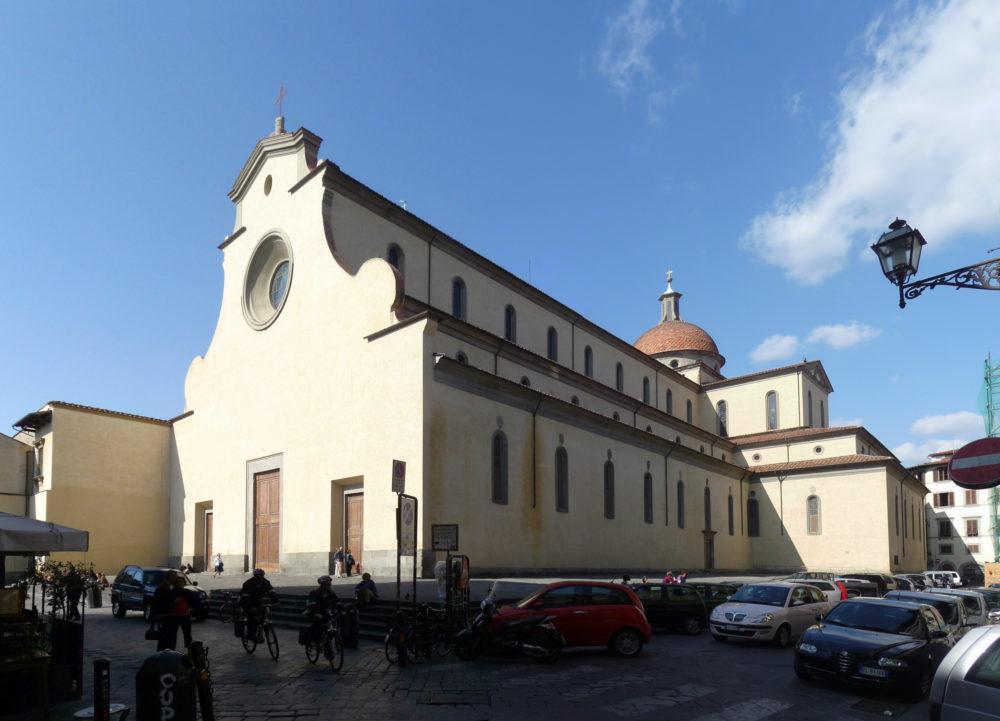
Basilica di Santo Spirito (photo: Wikimedia Commons)
Now that you’ve well and truly had your art fix in Florence, make your way to the historic Via Maggio for an unbeatable shopping and people-watching destination, lined with elegant old palaces. Along with the nearby Via dei Serragli, it’s a long treasure trove of antiques, vintage clothing boutiques, and artisanal botteghe (ateliers). Be sure to stop by number 26 via Maggio, where you’ll find a stunning renaissance palace once home to the mistress of a Medici. The Palazzo Blanco Cappelli is today remarkable for its connecting sgraffito black and white wall decor, unique on this street connecting to the magisterial, 16th-century Santa Trinità bridge with its three elliptical arches.
To take in an evening show in Oltrarno, check the varied events program at the exquisite Villa Strozzi (not to be confused with the Palazzo Strozzi on the other side of the river), in which the Limonaia makes for an unforgettable, intimate venue for concerts, theater, or even DJ sets.
Food and Drink
In Oltrarno, you are never more than a stone’s throw away from a refreshing Spritz or a mouthwatering gelato. And the Florentines do take their gelato seriously, claiming to be the first city ever to serve the chilled dessert, at the court of Catherine de’ Medici in the 16th century. Start with the Gelateria La Carraia on the bridge of the same name (black sesame is a personal favorite). Skip the queues on the Ponte Vecchio and continue along the river bank to the Cantina del Gelato, where you will be greeted by a cooling mist at the doorway on a hot day. Try Turmeric and fig, black rise, or lemon granita.
Trail off into a backstreet in the San Frediano to find the tiny, old-school Gelateria della Passera, where the owner, Cinzia, serves up joyfully simple flavor creations like artisanal coffee, olive oil, or banana, orange and nutmeg, with a handwritten menu that clearly indicates if the scoops are made with or without milk. Return to Santo Spirito for a taste of paradiso from the Gelateria La Sorbettiera, with its whimsical creations like salted ricotta, honey and bee pollen, or ‘limited edition’ concoctions like ‘Cream of San Giovanni’, infused with lavender, rose petals, basil, rosemary, sage, mint and thyme.
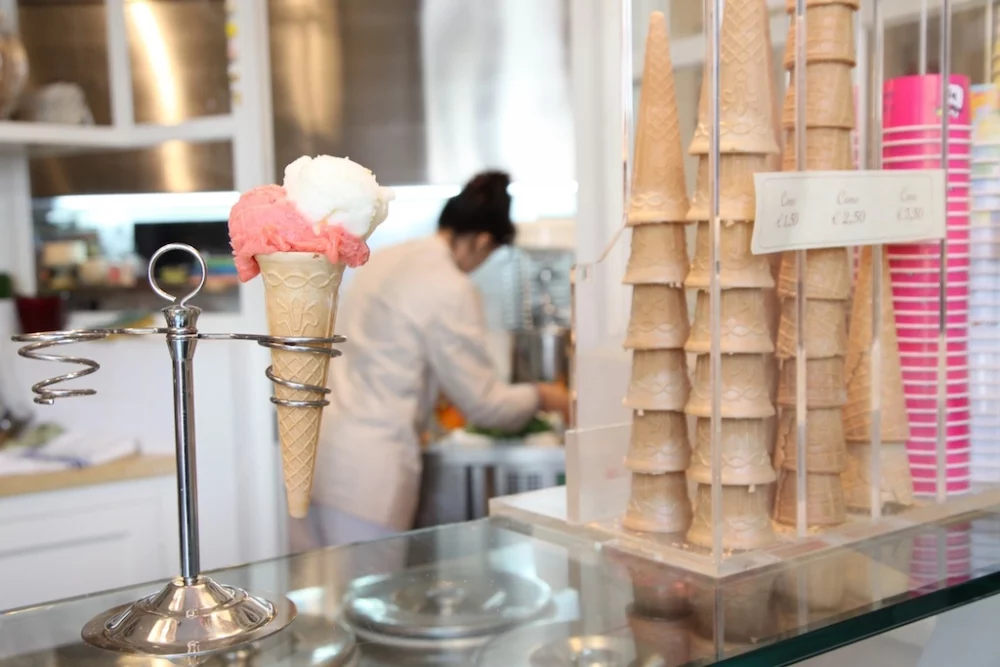
Gelateria della Passera (photo: gelaterialapassera.wordpress.com)
By night, Santo Spirito is a thriving hub for bars and eateries. Follow your nose to Gustapizza (via Maggio) near the Pitti Palace; although a long line of locals and tourists alike may await you at this well-priced Neapolitan pizzeria where even the humble margherita is bursting with flavor. You can dine in or take away for a melt-in-your-mouth experience. Gustapizza’s only rival in Oltrarno is Pizzeria O’Scugnizzo and its equally thin-doughed slices of happiness.
For refined Tuscan dining, Il Santo Bevitore (Via Santo Spirito) is the ideal modern restaurant in which to enjoy fresh seasonal ingredients. Opt for beautifully presented dishes like the treviso red chicory ravioli with polenta and fried baby shrimps, or tender veal cutlet with artichoke, borlotti beans and pears, with velvety white chocolate mousse or a cheese degustation platter for dessert.
Stroll along the Arno or down the cobbled backstreets to the trendy San Niccolò district, between the church and the stone archway leading to the Piazzale Michelangelo. Among the many laid-back wine bars and bistros is Il Rifrullo (Via di S. Niccolò), with its candlelit terrace, where they serve international cuisine with a Mediterranean flair and ample Sunday brunch. On the other side of the ancient city walls, an authentic Florentine enoteca (wine tasting bar) beckons: Fuori Porta (via del Monte alle Croci) is an ideal lunchtime or aperitivo spot, with tagliere (cold cuts) and bruschetta to accompany an extensive selection of local wines.
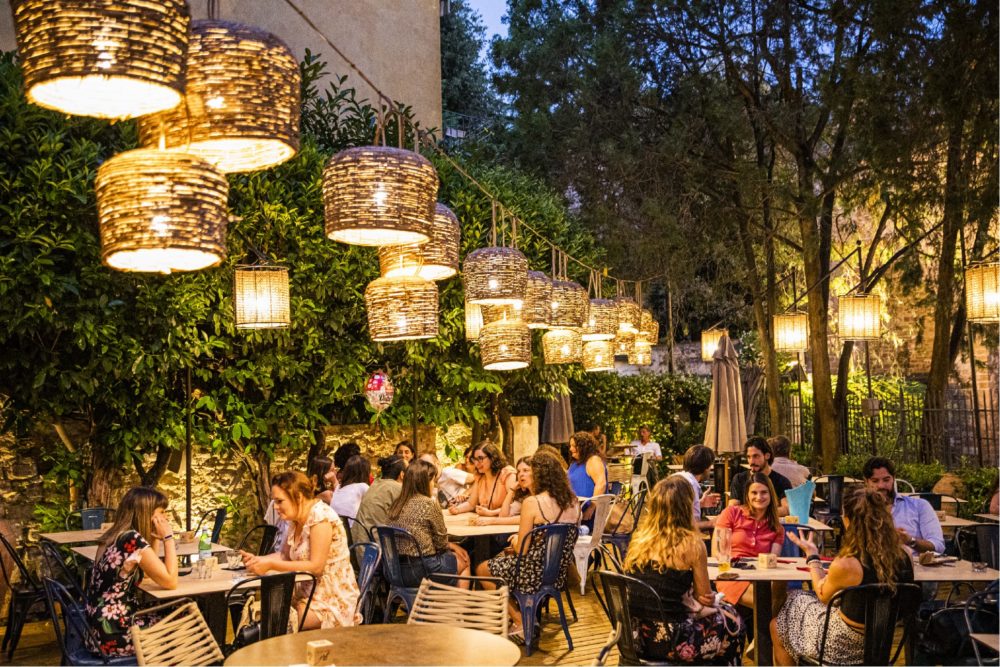
Il Rifrullo, San Niccolo (photo: ilrifrullo.com)
Keen to sample some real Florentine street food? Meat-lovers cannot help but be intrigued by lampredotto, a rustic dish using the fourth stomach of a cow. (Don’t think too much about it, just try it!) The small stand at ‘I Trippaio di San Frediano (Piazza dei Nerli) serves up a piping hot panino con lampredotto and salsa verde picante. Another unmissable specialty for lunch or a meal on the go, though perhaps difficult to pronounce if your Italian is rusty: schiacciata – warm, crispy focaccia with harmonious fillings of meat, cheese or grilled vegetables. Lo SchiacciaVino (via Pisana), still in San Frediano, has the typical peposo (Tuscan braised beef) as well as some more original fillings for their schiacciata, like shrimp.
At most traditional Florentine restaurants it can be hard for vegetarians and vegans to find options. However, they need look no further than L’Ov (Piazza del Carmine), a plant-based osteria in San Frediano. Here, ‘grandma’s’ eggplant parmagiana is bathed in stretchy vegan cheese (non-vegans are unlikely to taste the difference), fried zucchini flowers are crisp and sweet in their bell pepper sauce, and the riso carnaroli alla flora di mare (wakame risotto) is perfect for al fresco dining.
By night, linger on the Arno for a sunset the color of Aperol. The most relaxing spot along the banks is Circolo Rondinella (Lungarno Soderini), a bar that has been serving up cheap drinks, simple pasta and an incredible view since 1946, along with the occasional jazz concert amidst the outdoor tables. This is undoubtedly the beating heart of Oltrarno, where the best way to enjoy the river’s good vibes is stretched out with a Spritz or a cup of Prosecco in hand.
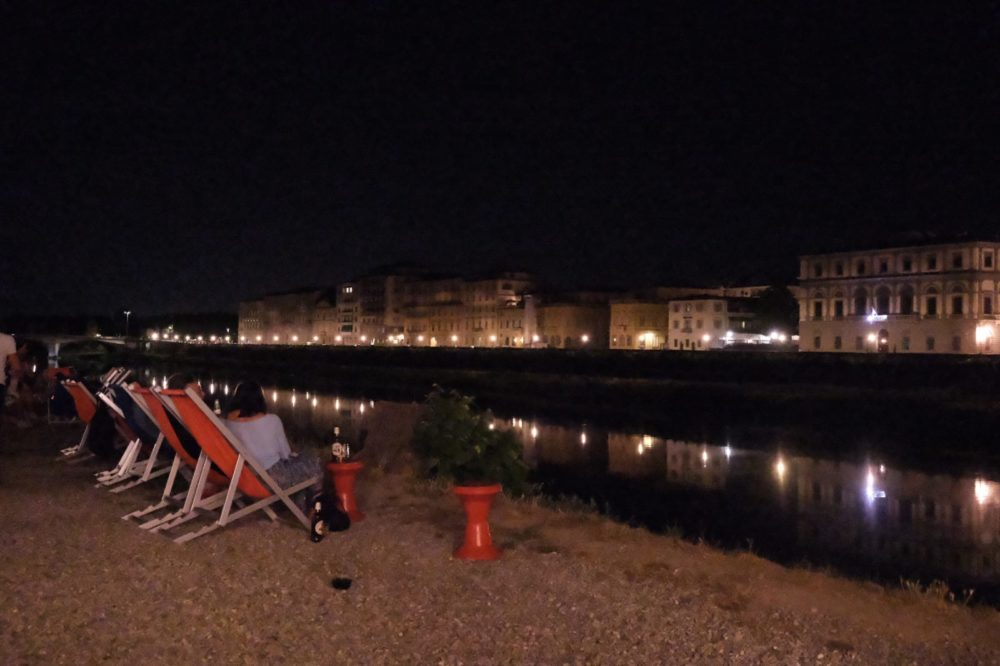
Night spritzing on the Arno (photo: Melissa Lesnie)
Where to stay
Florence has no shortage of breathtaking rooftop views, many of which are the draw cards for the most exquisite hotels in the city. In Oltrarno, one of the most splendid panoramas can be found at the top of the Hotel Palazzo Guadagni (Piazza Santo Spirito), with a plunging view of the Santo Spirito Basilica. Even if you’re not staying there, its Loggia roof bar is well worth a visit.
For truly unique accommodation, search for ‘medieval tower apartment’ on booking.com. You are likely to find several surprisingly affordable short-term rentals, giving you the chance to experience a few nights in a Florentine belltower (not to worry – they tend to be fitted out with wifi, air conditioning and other modern amenities), such as the leaf-covered, 13th-century Belfredelli or the neighboring Torre Ramaglianti near the Ponte Vecchio. Buona permanenza.
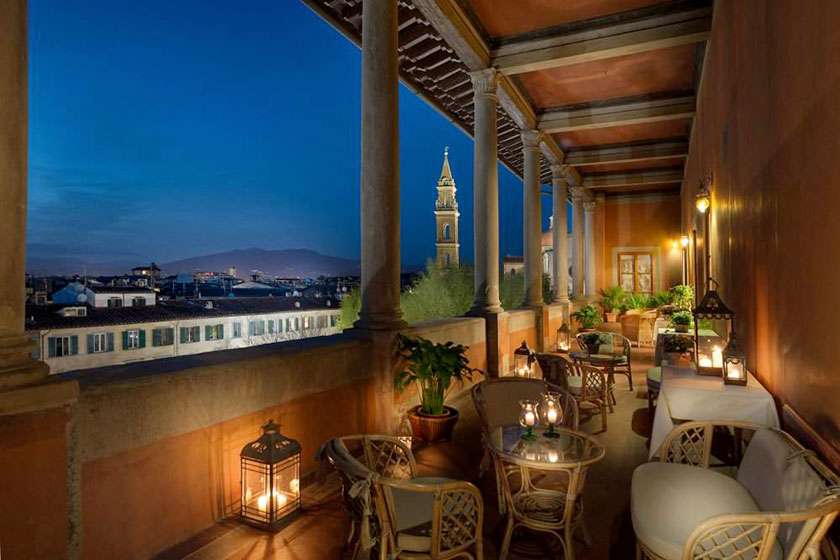 Loggia bar, Palazzo Guadagni (photo: palazzoguadagni.com)
Loggia bar, Palazzo Guadagni (photo: palazzoguadagni.com)